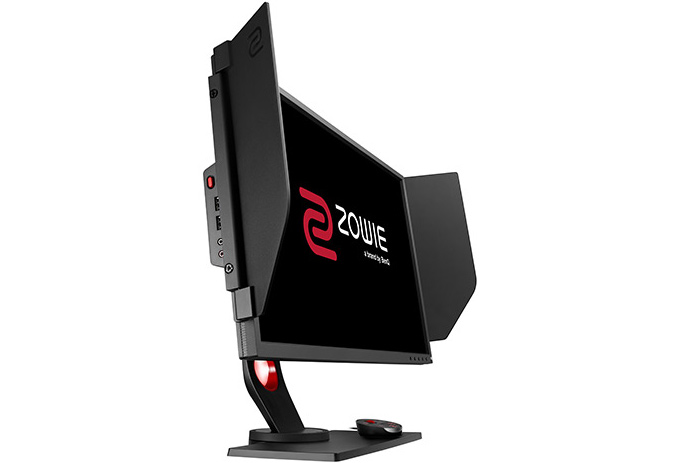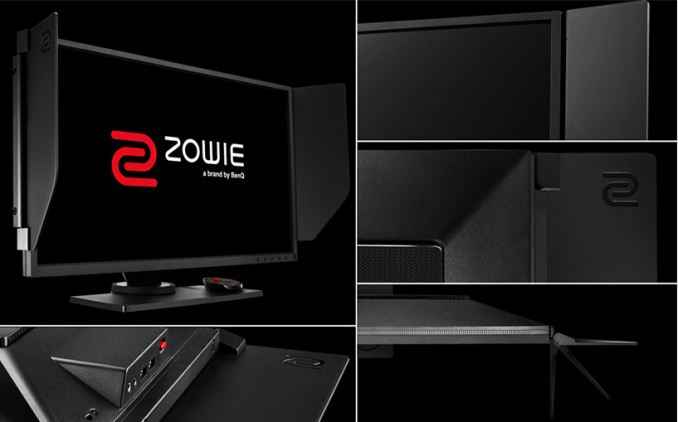BenQ Announces ZOWIE XL2546 ‘eSports’ Display: 24'', FHD, 240 Hz, DyAc ULMB Tech
by Anton Shilov on July 22, 2017 11:00 AM EST
BenQ this week introduced a new version of its ZOWIE XL2540 ultra-fast gaming display it launched last year. The improved device carrying the XL2546 model number has the same specifications as its predecessor, including a 1920×1080 resolution and a refresh rate as high as 240 Hz, but also adds BenQ’s proprietary DyAc (Dynamic Accuracy) technology designed to make fast-motion scenes a bit more clear.
The BenQ ZOWIE XL2540 monitor is one of the fastest gaming displays on the market today. The unit was launched in late 2016 and now BenQ launches its improved version, the ZOWIE XL2546 with DyAc. According to a preorder page at B&H, the new model mimics nearly the specs of the predecessor, then the new display features the same 24.5” TN panel from AU Optronics with a 1920×1080 resolution (it is the only 24" FHD panel with a 240 Hz refresh rate), supports for 16.7 million (6-bit + FRC) colors, has a typical contrast ratio for mainstream screens (1000:1), as well as offers a 320 cd/m2 brightness, which is lower compared to what the XL2540 offers (400 cd/m2). For some reason, with the ZOWIE XL2546, BenQ continues to ignore AMD’s FreeSync and NVIDIA’s G-Sync dynamic refresh rate technologies.
Two main features of the ZOWIE XL2546 display are its native 240 Hz refresh rate as well as the company’s DyAc (Dynamic Accuracy) technology that enhances the display's motion clarity. The manufacturer does not explain anything about this tech, but from various media reports (e.g., this one) it appears that the DyAc is BenQ's implementation of Ultra Low Motion Blur backlight strobing. ULMB reduces motion blur by inserting a black image between each frame of video and thus reducing time each frame is displayed. Given the hardware similarities between the monitors, I'm left to ponder of BenQ could have enabled this in current monitors via a firmware update, but for some reason BenQ decided not to add it to the ZOWIE XL2540, but to launch a new display instead.
Other interesting capabilities of the ZOWIE XL2540/XL2546 are the Black eQualizer that increases the brightness of dark areas without oversaturating the bright areas, an option to quickly increase color vibrancies, a special external controller to activate different settings and profiles rapidly, as well as a light-shielding hood (which BenQ calls a way to help gamers to focus on their games).
Just like the XL2540, the XL2546 uses DisplayPort 1.2, HDMI, and DVI-DL to connect to host PCs (though it should be noted that DVI does not support a 240 Hz refresh rate). In addition, the monitor has an integrated three-port USB hub and a PSU.
BenQ plans to showcase the ZOWIE XL2546 display at DreamHack Atlanta 2017 this weekend. The company does not disclose anything regarding the price or the ETA of the new unit officially, but B&H is charging $549 for the new unit, which is $50 higher compared to its predecessor.
Related Reading:
- BenQ Announces the ZOWIE XL2540: 24-Inch 240 Hz Full-HD Display 'for e-Sports'
- BenQ PD2710QC Announced: 27" 2560x1440 with Integrated USB Type-C Dock
- BenQ Launches the SW320: a 4K Display with HDR for Professionals
- Samsung Announces First Freesync 2 Monitors: CHG70 & CHG90 - Quantum Dots, Up to 49”, 144 Hz, DCI-P3
- Acer Predator X35 & ASUS ROG Swift PG35VQ Unveiled: 35-inch G-SYNC HDR Monitors - UltraWide, Curved, 200Hz
- AOC Launches the AG352QCX: 35-Inch 200 Hz 2560×1080 Curved Display with Adaptive-Sync
- Acer Predator Z35P Available for Order: Curved 35" with 3440×1440@120 Hz and G-Sync
- Acer Predator Z271UV Gaming Monitor: 1440p, 144-165Hz, G-Sync, Eye Tracking
Source: BenQ











40 Comments
View All Comments
Flunk - Sunday, July 23, 2017 - link
Obviously I meant higher input lag.wsjudd - Monday, July 24, 2017 - link
CRTs are hard to take to LAN parties though, and no new ones are being made (that I know of) :)cfenton - Sunday, July 23, 2017 - link
Oh, sure, I'm not saying that refresh rate doesn't matter. I understand why some people want it. I was just curious if that's all you get for an extra $400. It seems steep to me, but I'm not the target market. I play games, but not competitive FPS games. I thought maybe these also had better color accuracy or viewing angles than cheap TN panels. I guess not.lowlymarine - Sunday, July 23, 2017 - link
The maximum possible reduction in button-to-pixel latency in going from a <$200 144hz display and this $550 240hz one is 2.78ms. You'll excuse me if I don't believe that will ever matter in the real world, much less to the tune of over $300. Never mind that you can now get some 144hz 1080p VA panels (with FreeSync even) for under $400 that might at least have somewhat acceptable colors and viewing angles.Lolimaster - Monday, July 24, 2017 - link
If you care about being competitive you should play with a CRT <0.01ms of response time.Lolimaster - Tuesday, July 25, 2017 - link
IPS still got sh*tty contrast with the horrid IPS glow, at least VA fixes that.Flunk - Sunday, July 23, 2017 - link
If you care about colour accuracy, the high refresh-rate TN screens are not for you.edzieba - Saturday, July 22, 2017 - link
"ULMB reduces motion blur by inserting a black image between each frame of video and thus reducing time each frame is displayed. "ULMB works by pulsing the backlight once for a short period for every frame (rather tahn the normal technique of keeping the backlight illuminated cosntantly). All 'inserting a black frame' does is allow for padding the framerate number, and has nothing to do with ULMB itself.
Diji1 - Saturday, July 22, 2017 - link
Aren't you both saying the same thing? A black frame is one where the back light is turned off.ridic987 - Saturday, July 22, 2017 - link
He is clarifying that it is not 120 frames and 120 black frames per second. It is instead the monitor turning the backlight off between frames.